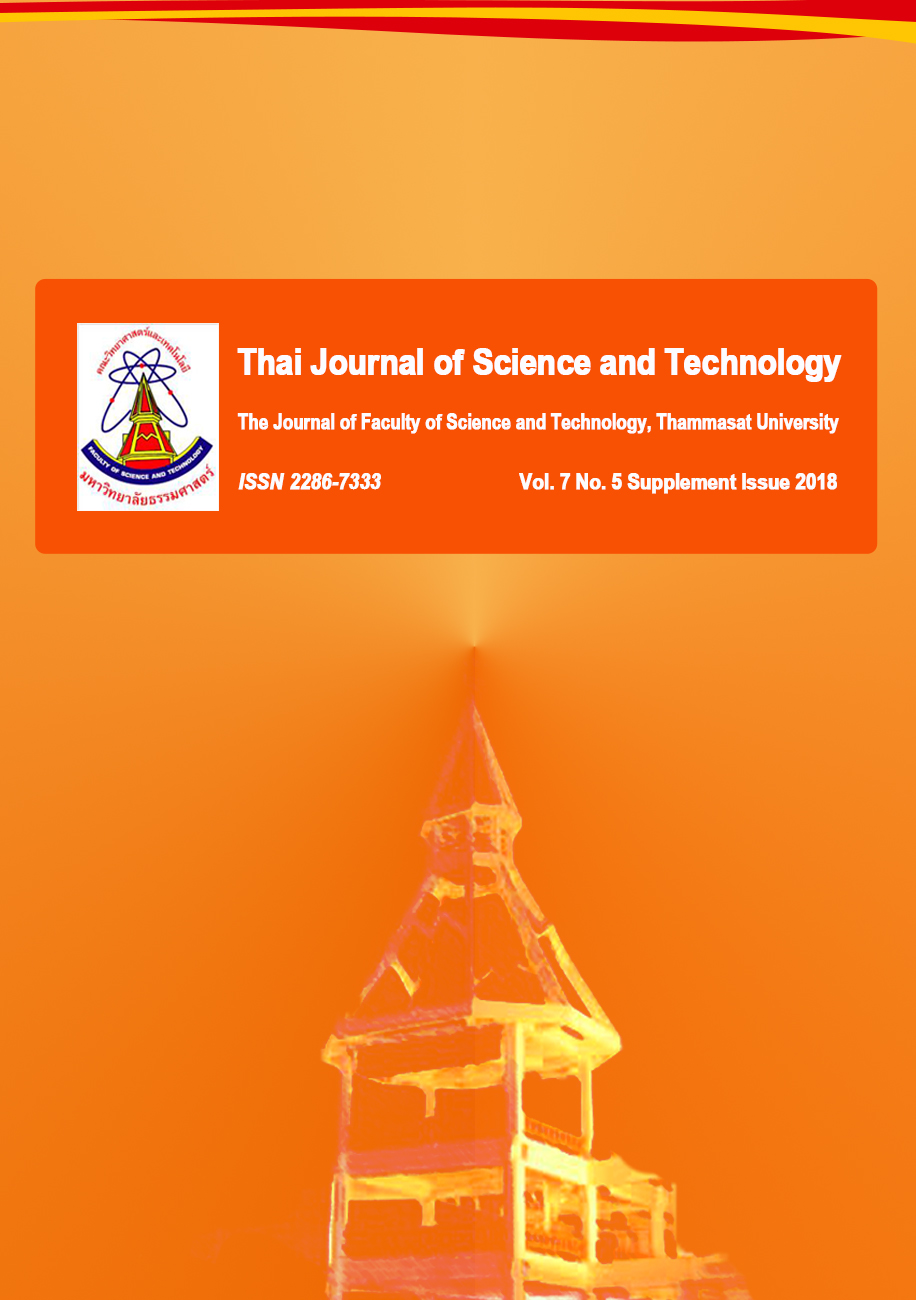การประเมินลักษณะรากข้าวในประชากรชั่วที่ 2 จากคู่ผสมระหว่างข้าวนาสวนและข้าวไร่
Main Article Content
Abstract
Abstract
Good root traits are targeted phenotypes for improving rice yield under drought condition. The shallow-rooting rice cultivars with good economic trait could be improved root system architecture for drought tolerance. In this study, the root traits were evaluated in 126 F2 progenies derived from a cross between lowland rice, RD49 and upland rice, Prayaleumgang (PLG) rice varieties. The parental varieties and F2 progenies were evaluated for shallow root number (SRN), deep root number (DRN), total root number (TRN) and ratio of deep rooting (RDR) using the basket method. The result showed that PLG had higher DRN and RDR than RD49 but lower shallow SRN than RD49. The TRN was not significantly different between PLG and RD49. In F2 population, SRN, DRN, TRN and RDR ranged from 5 to 153, 4 to 106, 9 to 210 roots and 8.0 to 65.5 percent, respectively. SRN, TRN and RDR showed normal distribution and transgressive segregation in the F2 population. Thus, the rice lines carrying high ratio of deep rooting and total root number can be selected in this segregating population.
Keywords: rice; root system; drought tolerant; total root number; ratio of deep rooting
Article Details
บทความที่ได้รับการตีพิมพ์เป็นลิขสิทธิ์ของคณะวิทยาศาสตร์และเทคโนโลยี มหาวิทยาลัยธรรมศาสตร์ ข้อความที่ปรากฏในแต่ละเรื่องของวารสารเล่มนี้เป็นเพียงความเห็นส่วนตัวของผู้เขียน ไม่มีความเกี่ยวข้องกับคณะวิทยาศาสตร์และเทคโนโลยี หรือคณาจารย์ท่านอื่นในมหาวิทยาลัยธรรมศาสตร์ ผู้เขียนต้องยืนยันว่าความรับผิดชอบต่อทุกข้อความที่นำเสนอไว้ในบทความของตน หากมีข้อผิดพลาดหรือความไม่ถูกต้องใด ๆ
References
ชวนชม ดีรัศมี, มุ่งมาตร วังกะ, ดวงกมล บุญช่วย, ชัยรัตน์ จันทร์หนู, ดวงพร วิธูรจิตต์, สุรเดช ปาละวิสุทธิ์, อัจฉราพร ณ ลําปาง เนินพลับ, วิไล ปาละวิสุทธิ์, สุพัตรา สุวรรณธาดา, วรรณกรณ์ อินทรสถิตย์, ภมร ปัตตาวะตัง, สอาง ไชยรินทร์, เจตต์ คชฤกษ์, ดวงอร อริยพฤกษ์, ควพร พุ่มเชย, เบญจวรรณ พลโคต, พรสุรี กาญจนา, จิตติชัย อนาวงษ์, จัตุรงค์ พิพัฒน์พิริยานนท์, เปรมกมล มูลนิลตา, วิภาวดี ชํานาญ, นัยกร สงวนแก้ว, วันทนา ศรีรัตนศักดิ์ และรัศมีฐิติ เกียรติพงศ์, 2556, กข 49 : ข้าวนาชลประทานผลผลิตสูง ต้านทานเพลี้ยกระโดดสีน้ำตาล, น. 33-54, การประชุมวิชาการข้าวและธัญพืชเมืองหนาว ครั้งที่ 30, โรงแรมมารวยการ์เด้น, กรุงเทพฯ.
สำนักงานเศรษฐกิจการเกษตร, 2559, สถาน การณ์สินค้าเกษตรที่สำคัญและแนวโน้ม ปี 2560, แหล่งที่มา : http://www.oae.go.th/download/document_tendency/agri_situation2560.pdf, 17 มีนาคม 2560.
สีกุน นุชชา, อัตราพันธุกรรม, แหล่งที่มา : http://www.seekun.net/a-im-4-4-2.pdf, 26 กุมภาพันธุ์ 2561.
สุทัศน์ ศรีวัฒนพงศ์, 2553, การปรับปรุงพันธุ์พืช, พิมพ์ครั้งที่ 3, สำนักพิมพ์มหาวิทยาลัย เกษตรศาสตร์, กรุงเทพฯ, 259 น.
Ali, M., Pathan, M., Zhang, Bai, J., Sarkarung, G.S. and Nguyen, H.T., 2000, Mapping QTLs for root traits in a recombinant inbred population from two indica ecotypes in rice, Theor. Appl. Genet. 101: 756.
Gowda, V., Henrya, R., Yamauchic, P.A.A., Shashidharb, H.E. and Serraj, R., 2011, Root biology and genetic improvement for drought avoidance in rice, Field Crops Res. 122: 1-13.
Janwan, M., Sreewongchai, T. and Sripijitt, P., 2012, Rice breeding for high yield by advanced single seed desenct method od selection, J. Plant Sci. 8: 24-30.
Kondo, M., Pablico, P.P., Aragones, D.V., Agbisit, R., Abe, J., Morita, S. and Courtois, B, 2000, Genotypic and environmental variations in root morphology in rice genotypes under upland field conditions, Plant Soil 255: 189-200.
Kumar, A., Dixit, S., Ram, T., Yadaw, R.B., Mishra, K.K. and Mandal, N.P., 2014, Breeding high-yielding drought-tolerant rice: Genetic variations and conventional and molecular approaches, J. Exp. Bot. 65: 6265-6278.
Li, J., Wang, D., Xie, Y., Zhang, H., Hu, G., Li, J., Dai, A., Liu, L. and Li, Z., 2011, Development of upland rice introgression lines and identification of QTLs for basal root thickness under different water regimes, J. Genet. Genomics 38: 547-556.
Mohanty, S., Wassmann, R., Nelson, A., Moya, P. and Jagadish, S.V.K., 2013, Rice and Climate Change: Significance for Fod Security and Vulnerability, IRRI Discussion Paper Series No. 49., International Rice Research Institute, Los Baños, 14 p.
O’Toole, J.C. and Bland, W.L., 1987, Genotypic variation in crop plant root systems, Adv. Agron. 41: 91-145.
Obara, M., Wataru, T., Takeshi, E., Masahiro, Y., Tadashi, S. and Tomoyuki, Y., 2010, Fine-mapping of qRL6.1, a major QTL for root length of rice seedlings grown under a wide range of NH4+ concentrations in hydroponic conditions, Theor. Appl. Genet. 121: 535-547.
Pantuwan, G., Ingram, K.T. and Sharma, P.K., 1996, 198-206, Rice root systems development under rainfed conditions, In Physiology of Stress Tolerance in Rice, Proceedings of the International Conference on Stress Physiology of Rice, Lucknow, U.P.
Riseberg, L.H., Archer, M.A. and Wayne, R.K., 2003a, Transgressive segregation, adaptation and speciation, Heredity 83: 363-372.
Riseberg, L.H., Widmer, A., Arntz, A.M. and Burke, J.M., 2003b, The genetic architecture necessary for transgressive segregation is common in both natural and domesticated populations, Phil. Trans. R. Soc. Lond. B. 358: 1141-1147.
Uga, Y., Kitomi, Y., Ishikawa, S. and Yano, M., 2015, Genetic improvement for root growth angle to enhance crop production, Breed Sci. Mar. 65: 111-119.
Uga, Y., Kitomi, Y., Yamamoto, E., Kanno, N., Kawai, S., Mizubayashi, T. and Fukuoka, S., 2015, A QTL for root growth angle on rice chromosome 7 is involved in the genetic pathway of DEEPER ROOTING 1, Rice 8: 8.
Uga, Y., Okuno, K. and Yano, M, 2011, Dro1, a major QTL involved in deep rooting of rice under upland field conditions, J. Exp. Bot. 62: 2485-2494.
Wu, W. and Cheng, S., 2014, Root genetic research, an opportunity and challenge to rice improvement, Field Crops Res. 165: 111-124.


